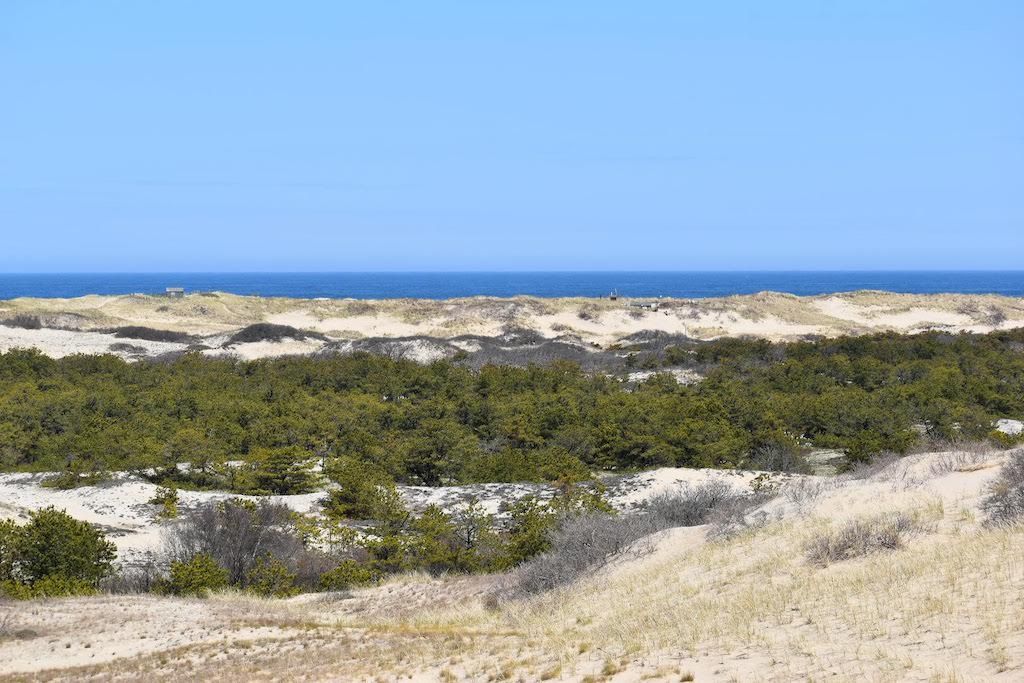I'd been coming to Cape Cod for almost three decades before my first walk on the Dune Shack Trail. After seeing an Instagram Post showing the dramatic landscape of the area, I drove to Provincetown for a hike with my two boys and one of their cousins. We parked on the side of Route 6, walked to the trail head, kicked off our shoes, and started to make our way up a giant sand dune. When we reached the top, I looked around at the rolling dunes, barren scrub brush, and distant ocean and thought: I've just landed on a Star Wars movie set. I know I am offroading from my usual tech topics again, but this is one of those must-see hikes for anyone heading to Cape Cod this summer. Here are the details:
The Walk
The Peaked Hill Bars Historic District offers one of the most dramatic hikes on Cape Cod. It starts at an unmarked trail head on Route 6 and takes you through the dunes to the ocean. The walk is about two miles roundtrip, but will feel more like twice that due to the soft sand and high dunes. A few minutes into your walk you will find yourself in a remote area of the Cape, with open land in all directions. The landscape is isolated and barren, and you will encounter beach grass, scrub pines, cranberry bogs, dunes and pristine beaches along the way. I usually allocate a couple hours for this hike, including a little R&R time at the beach. You will pass several dune shacks on the trail, which were the home to many famous artists over the years. The walk is mostly on soft sand, and thus can be challenging to some hikers. But this is one of those not-to-miss hikes you need to experience at least once.
Slideshow
History
For all its beauty, Peaked Hill Bars is the site of an ecological disaster. Before the arrival of Europeans, there was once a great forest here whose roots were anchored in several feet of rich topsoil. But the new settlers cleared the land of trees and vegetation to support their farming and livestock grazing, and by the mid-1800s, the top soil had blown away and was replaced with the shifting dunes you see today. The “Peaked Hill” name actually comes from a high point in this area that has since blown into the ocean. While the land will never return to what it once was, there is an active dune restoration project that is planting beach grass in hope of stabilizing the dunes.
To tell the story of Peaked Hill Bars you must first tell the story of the Atlantic shores of Cape Cod, which are known as one of the most dangerous in the US (3,000+ shipwrecks in 50 miles of seashore). Due to the remoteness of the seashore, crew members who were fortunate enough to get to land would often freeze to death before help could arrive. In 1797, the Massachusetts Humane Society constructed huts in the remote areas of the Cape to provide emergency shelter and supplies for shipwreck survivors. This was followed in 1871 by the creation of the United States Life-Saving Service, which installed manned stations every five miles along the beach. By 1900 there were thirteen lifesaving stations along these shores, with one still surviving to this day (Old Harbor Life-Saving Station at Race Point Beach in Provincetown).
While the men of the United States Life-Saving Service were the first dune dwellers in this area, it wasn’t long before other Cape Codders decided to make a home here too. The first dune shack to appear on a map was in 1880. By the early 20th century, with Cape Cod becoming a tourist destination, the state built Route 6 (1926) to provide easy access to the peninsula, and the summer population grew. The 1920s saw more dune shacks being built, with many lived in by famous writers and artists, including Jackson Pollock, Normal Mailer, Jack Kerouac, Tennessee Williams and E.E. Cummings. These shacks offered primitive dwellings where writers, poets and painters could disconnect from the world and focus on their art.
In the 1950s, the Department of Interior launched a major initiative to create new federal parks to preserve our rapidly disappearing national seashores. In a 1961 act of Congress, the Cape Cod National Seashore was created, preserving 43,000 acres that includes Peaked Hill Bars. The federal take-over of land received resistance from the owners of the dune shacks, with the last court case dragging out until 1991. Today there are 19 dune shacks remaining, which are owned today by non-profit organizations that continue to offer them to artists.
Last Thoughts
Parking is on the side of road on Route 6, where you will typically see other cars pulled over over. The best way to walk the dunes is with no shoes. After entering the woods at the trailhead, you will see a dune rise in front of you. It’s common for people to kick off their shoes here and walk barefoot through the trail. You of course have to trust in your fellow hikers that your shoes will be there when you get back - but I have never had an issue. If you have an interest in actually staying in one of the shacks, the non-profit that owns them hold an annual lottery for the public (e.g. The Compact). Also, try to stay on the trail and not trample the beach grass - it's critical to stabilizing this ecosystem.
I hope you enjoy your hike. It's as close to Tatooine as your will ever get on earth. 😉
